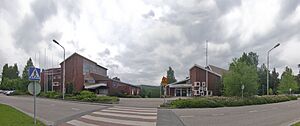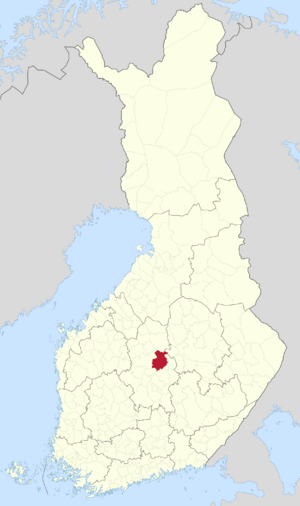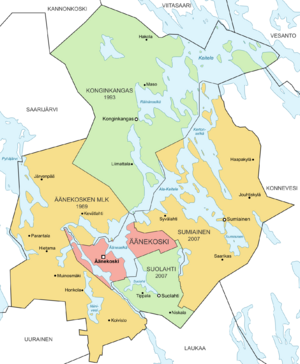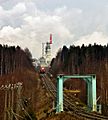Äänekoski facts for kids
Quick facts for kids
Äänekoski
|
||
|---|---|---|
|
Town
|
||
| Äänekosken kaupunki Äänekoski stad |
||

Äänekoski town hall and library
|
||
|
||

Location of Äänekoski in Finland
|
||
| Country | ||
| Region | Central Finland | |
| Sub-region | Äänekoski sub-region | |
| Charter | 1932 | |
| City rights | 1973 | |
| Area
(2018-01-01)
|
||
| • Total | 1,138.39 km2 (439.53 sq mi) | |
| • Land | 884.61 km2 (341.55 sq mi) | |
| • Water | 253.84 km2 (98.01 sq mi) | |
| Area rank | 87th largest in Finland | |
| Population
(2023-12-31)
|
||
| • Total | 17,971 | |
| • Rank | 64th largest in Finland | |
| • Density | 20.32/km2 (52.6/sq mi) | |
| Population by native language | ||
| • Finnish | 97.1% (official) | |
| • Swedish | 0.1% | |
| • Others | 2.8% | |
| Population by age | ||
| • 0 to 14 | 15.2% | |
| • 15 to 64 | 56.8% | |
| • 65 or older | 27.9% | |
| Time zone | UTC+02:00 (EET) | |
| • Summer (DST) | UTC+03:00 (EEST) | |
Äänekoski (pronounced "AA-neh-kos-kee") is a town in Finland. It's located in the Central Finland region, about 45 kilometers (28 miles) north of Jyväskylä, which is the region's main city. Äänekoski is home to about 18,300 people. A big part of its area, about 22%, is covered by water, like lakes and rivers.
Äänekoski shares borders with several other towns. These include Kannonkoski, Konnevesi, Laukaa, Saarijärvi, Uurainen, Vesanto, and Viitasaari. The town officially uses only the Finnish language. Over the years, several smaller areas have joined Äänekoski. These include Äänekosken maalaiskunta (in 1969), Konginkangas (in 1993), and Sumiainen and Suolahti (in 2007).
Contents
A Look Back at Äänekoski's Past
Äänekoski gets its name from the rapids nearby. Some people think the name comes from the Finnish word ääni, meaning "sound." This might be because of the sound the rapids make. However, another idea suggests it comes from an old Sámi word meaning "big" or "large."
Around the year 1455, Swedish records mention a place called Ænækoski laxefiskeri. This was a salmon fishing spot near the rapids. At that time, it wasn't a proper town. It was part of the hunting grounds used by people from Sysmä.
Later, in 1561, the Rautalampi church area was created. This was a very large area covering most of Central Finland. In 1628, the Laukaa church area, which included Äänekoski, became separate.
A settlement named Äänekoski has existed since at least 1752. It stayed part of Laukaa until 1907, when its own church area was formed. Then, in 1911, the municipality (a local government area) of Äänekosken maalaiskunta was created. At first, it was just called Äänekoski.
In 1932, the municipality was divided. The main settlement of Äänekoski became a kauppala, which is like a market town. Suolahti also became a kauppala. The original Äänekoski municipality was renamed Äänekosken maalaiskunta, and its main office moved to Honkola village. Even after this split, Äänekoski and Äänekosken maalaiskunta still shared the same church area.
The first factories and businesses started to appear in Äänekoski between 1896 and 1900. This marked the beginning of its industrial growth.
Over time, Äänekoski grew by combining with other municipalities. These mergers happened in 1969 (with Äänekosken maalaiskunta), 1993 (with Konginkangas), and 2007 (with Sumiainen and Suolahti). When Sumiainen and Suolahti joined in 2007, Äänekoski started using the coat of arms (a special symbol or emblem) that Suolahti had used before.
Exploring Äänekoski's Geography
Äänekoski is located along Finnish national road 4. This road is about 40 kilometers (25 miles) north of Jyväskylä. Another important road, Finnish national road 69, starts nearby and goes towards Suonenjoki. Finnish national road 13, which connects Kokkola and Lappeenranta, also passes through the area.
The center of Äänekoski is nestled between two parts of a large lake system: Ääneselkä (part of Lake Keitele) and Lake Kuhnamo.
Äänekoski's Villages and Neighborhoods
Because Äänekoski has merged with other municipalities, it includes many different villages. Some of the officially named villages from the former areas are:
- Konginkangas: Kalaniemi, Konginkangas center, Pyyrinlahti
- Sumiainen: Paadentaipale, Raikkaus, Sumiaisten kirkonkylä (Sumiainen church village)
- Suolahti: Suolahti center
- Äänekoski and Äänekosken maalaiskunta (Rural Municipality of Äänekoski): Äänekoski center, Honkola, Kangashäkki, Kiimasjärvi, Koivisto (Koivistonkylä), and Petruma.
Besides these official areas, there are also other well-known neighborhoods. These include Hietama, Hirvaskangas, Laajaranta, Liimattala, Mämme, Parantala, and Rannankylä.
Nature and Lakes in Äänekoski
Äänekoski is a very green area with lots of forests. It's also known for its many lakes, especially the large Lake Keitele. This lake has many bays and stretches in different directions.
The area is home to 13 special protected areas called Natura 2000 sites. These places protect important natural features, like sandy ridges (called eskers), lakes with many birds, and parts of a deep ravine area.
In total, Äänekoski has 170 lakes! The biggest ones are Lake Keitele, Kuhnamo, and Niinivesi. You can also find one of the world's smallest rivers here, called the Kuokanjoki.
People Living in Äänekoski
In 2021, Äänekoski had 18,318 people living there. Most of these people, about 75.8%, lived in urban areas, which are like towns or cities.
There are three main urban areas in Äänekoski:
- Äänekoski center, which has about 12,899 people.
- Konginkangas, with about 445 people.
- Sumiaisten kirkonkylä (Sumiainen church village), with about 406 people.
Some areas that used to be counted as separate urban areas, like Suolahden keskustaajama (the center of Suolahti), Kierälahti, and Paatela, are now considered part of the larger Äänekoski center.
Äänekoski's Economy and Industries
Äänekoski is an important place for industry. Many factories and businesses operate here.
One of the biggest companies that pays taxes in Äänekoski is Valtra. This company makes tractors and other machines for farms. Valtra is part of a larger company called AGCO Corporation. Another important company is Kurikka Timber, which makes parts for windows.
You might also know Äänekoski for its food! The famous Aura cheese is made here at the Valio dairy factory.
The forest, pulp, and paper industry is also a very big employer in Äänekoski. This industry has a long history here, starting with a pulp mill and cardboard factory in 1891. Today, several large companies have facilities in Äänekoski:
- Metsä Board has a factory that makes folding boxboard, which is used for packaging.
- Metsä Fibre operates a large mill that produces kraft pulp and other bioproducts from wood.
- Metsä Wood has a plywood factory.
- Nouryon has a plant that makes special chemicals from cellulose, which comes from trees.
Twin Towns – Sister Cities
Äänekoski has special partnerships with other cities and municipalities around the world. These are called twin towns or sister cities. They often share cultural exchanges and friendly relationships.
Äänekoski is twinned with:
 Örnsköldsvik Municipality, Sweden
Örnsköldsvik Municipality, Sweden Brande, Brande Municipality, Denmark
Brande, Brande Municipality, Denmark Sigdal, Norway
Sigdal, Norway Alushta, Alushta municipality, Ukraine
Alushta, Alushta municipality, Ukraine Borovichi, Novgorod Oblast, Russia (the status of this partnership is currently unknown)
Borovichi, Novgorod Oblast, Russia (the status of this partnership is currently unknown) Sestroretsk, Russia
Sestroretsk, Russia Niamey, Niger
Niamey, Niger
Gallery
-
A beautiful sunset over Lake Keitele.
See also
 In Spanish: Äänekoski para niños
In Spanish: Äänekoski para niños








